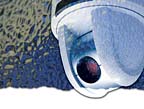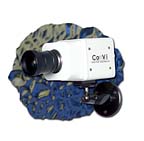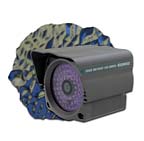
Security cameras are more powerful than ever. Domed and pan/tilt/zoom (PTZ) models are hot, as are illuminated models that can capture images in low light and day/night models that provide color images during the day and black-and-white images at night. Internet protocol (IP)-based cameras that can be connected directly to a data network also are starting to catch on. Meanwhile, technology advances are pushing costs down.
“It’s amazing what you can get now,†exclaims Gary Clinton, vice president of camera vendor Clinton Electronics, Loves Park, Ill. He points to the company’s new 400-line, 0.4-lux camera with automatic white balance and gain control that sells for $68. “Two years ago, it would have been a $200 camera," he says. Clinton attributes price decreases to increased competition among camera component manufacturers and increased capacity in offshore manufacturing facilities.

Decreasing Costs
Decreased costs also are helping to drive the increased popularity of illuminated and day/night cameras. “Now that the price gap is closing between color and infrared-illuminated cameras, we’re seeing a lot of traction for our IR-illuminated cameras that provide their own light source that is invisible to the human eye,†claims Nick Rizzuto, product development manager for Digimerge.Perry Whisnant, owner of Metro Waste, Charlotte, N.C., likes the Digimerge camera because of its versatility. If part of a room is bright enough for color and another part of the room is only bright enough for black and white, the camera will display an image that is partly black and white and partly color. “It can do both at the same time,†Whisnant says.
One security dealer who is using more IR-illuminated cameras is John Dyess, owner of Dyezz Surveillance and Security, Austin, Texas. Dyess is particularly happy with a model that he buys from Speco. “You can put it in a nightclub and the smoke from the smoke machine won’t affect it,†he says. “It has eight infrared LEDs that provide light and we sell 150 to 200 of them a month.â€

Remote Video also has been using more cameras with varifocal lenses. Today such cameras cost about $15 more than conventional cameras – and the convenience they add is well worth it, according to Scholl. “Now if a customer wants a tighter or wider shot, one lens fits all,†he says.

Dome Popularity Rising
The increased popularity of domed and PTZ cameras is being driven by their increased flexibility. Bolide, for example, recently introduced a high- resolution, low-lux, PTZ domed camera. David Liu, Bolide vice president, says customers increasingly want PTZ capability so they can adjust coverage to view an entire secured area. “People now are more security-oriented and they’re looking for those kinds of products,†Liu says.IPIX Security, a manufacturer that is popular in high-security governmental applications, also has noted this trend. To address it, IPIX brought out a domed PTZ camera that rotates 360 degrees vertically and horizontally, which was used during the recent presidential inauguration. Clara Conti, president and CEO of IPIX, explains, the camera uses a “virtual†PTZ control. To control the view from a camera, users “no longer have to go directly to the camera – they can pan, tilt or zoom real-time or forensically, and any number of users can be using the same camera.†Conti adds that IPIX domed cameras can be used to replace as many as four conventional cameras. Customers with large installations that include thousands of cameras are looking at simplifying their systems by making a change-out, she says.
CoVi Technologies also offers customers non-mechanical PTZ capability on its new camera model that uses a high-definition sensor. The main image from this camera, which is displayed on the top two-thirds of the user’s viewing screen, is 33 percent wider than for a traditional camera. That leaves an additional area at the bottom of the screen for display of an alternate image that can involve a pan, tilt, zoom or combination. “Instead of moving the camera, you’re moving inside the high-definition sensor,†explains Stuart English, vice president of marketing at CoVi. “It emulates what the PTZ does, but does it electronically.†English says customers using the new camera have found that it provides more accurate images and reduces cost – in part because one camera can replace two, but also because it acts as a better deterrent, because people cannot tell which way the camera is pointed.

One dealer that has been using more PTZ cameras is D&R Electronics of Northridge, Calif. D&R installation supervisor Eddie Henry attributes PTZ’s increased popularity to the growth of video systems that can be remotely viewed and controlled. The company sells a lot of high-end residential installations and, Henry says, “a pan-tilt-zoom is a better product for a higher-tech type of customer who likes being able to use a personal computer interface to be in London and to be able to monitor his home with a PTZ camera.â€
Henry is particularly fond of a new domed PTZ camera from Infinova, which has a video encoder built in. “The Infinova PTZ products overwhelmed me because of the distance they were able to capture and the clarity they’re able to capture,†Henry says.
Panasonic has made some advances in PTZ functionality, recently introducing a model with built-in auto tracking that enables the camera to automatically follow the largest object around the field-of-view. The company also has added vibration reduction to both PTZ and fixed cameras. “This is extremely useful when you’re recording because you can record without increasing storage requirements with motion-based DVRs,†explains Steve Surfaro, director of Panasonic’s enterprise project group.
Panasonic also has introduced a fixed camera with automatic back-focus. “It essentially auto-focuses the image when the camera has a dramatic light change, like when a switchover from color to black and white occurs,†Surfaro says.

IP Catches on
Although not yet mainstream, IP security cameras are beginning to catch on, as manufacturers have begun to address initial concerns and to add capabilities not possible with analog cameras.“The perception that network cameras were not up to par was probably true two years ago,†admits Fredrick Nilsson, U.S. general manager for Axis Communications, developer of an innovative IP camera line. “Today they have not only caught up but surpassed analog cameras.â€
While analog cameras are limited to the 0.4 megapixel resolution defined by the NTSC standard, digital cameras can surpass that level. “Today we go up to 1.3 megapixels,†Nilsson says. The newest IP camera from Axis also includes a serial port that can accept data from auxiliary devices, such as bar code readers on a production line, which can be recorded along with the video images.
Another advantage of IP cameras is the ability to support power-over-Ethernet, Nilsson says. This enables a single cable to be used for power and data. And networked dome cameras can do PTZ over the same IP-based network that is controlling the video, eliminating the need for a separate switch for PTZ.

Even recording capability could move out to the camera, adds Rohrbach. This would be accomplished using single board compression and would help to address concerns that some dealers have about potential data network failures. MDI has the ability to develop such IP capabilities, Rohrback says, but is waiting until the market is ready for them.

